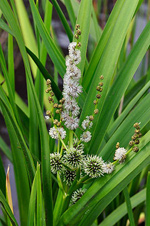|
||||||
|
SPARGANIUM. Bur-reeds. [Sparganiaceae] |
|
|
Four species of Sparganium are recorded in Britain. These include the native Floating Bur-reed (S. angustifolium), Unbranched Bur-reed (S. emersum), Branched Bur-reed (S. erectum) and Least Bur-reed (S. natans). The BSBI provide a downloadable plant crib for Sparganium. Four British miners are recorded on Sparganium. A key to the European miners recorded on Sparganium is provided in Bladmineerders van Europa. |
|
|
Key for the identification of the known mines of British |
1a > Tunneler: Half-mine; a one cm long straight tunnel along the midline of the upperside of the leaf; larva rests in this retreat during the day, emerging to devour the upper epidermis of the leaf during the hours of darkness. Feeding occurs from both ends of the retreat to a similar degree (Bland, 1994a). The larvae of a number of species of Chironomidae (non-biting midges) live in tunnels in decaying leaf sheaths under water. Their tunnels are open at both ends, and the larvae feed on particles they obtain from a water current they create in the tunnels. They do not feed on tissues of their 'hostplant' and therefore are not strictly miners. |
|
Cricotopus tricinctus (Meigen, 1818) [Diptera: Chironomidae]. |
1b > Leaf-miner: Full depth or lower-surface blotch, usually near the attachement of the petiole. Older larvae do not mine any longer but live in a flat case, made out of leaf fragments, and cause window feeding at the leaf underside. It mines the leaf for the first three days and then forms a flat case from which the larva feeds. |
|
Elophila nymphaeata (Linnaeus, 1758) [Lepidoptera: Crambidae]. |
1c > Leaf-miner: When young, the larva mines mainly the leaves or the stem of Sparganium or Nuphar lutea. It hibernates. Later it lives amongst spun leaves just below the surface of the water. Pupation in a white silk cocoon attached to the foodplant at or just below the water-level (Belgian Lepidoptera). Long narrow corridor, on or alongside the midrib. The corridor may descend below the water surface, and does contain frass. After some time the larva cuts itself a case out of the mine, and continues living free, partly under water. |
|
Nymphula nitidulata (Hufnagel, 1767) [Lepidoptera: Crambidae]. |
1d > Leaf miner / Stem-borer: Narrow gallery in a young leaf. After having mined for some time the larva becomes a borer in the stem or rhizome. The larvae feed inside the stems. |
|
Orthotelia sparganella (Thunberg, 1788) [Lepidoptera: Glyphipterigidae]. |
| Last updated 07-Jul-2019 Brian Pitkin | ||

